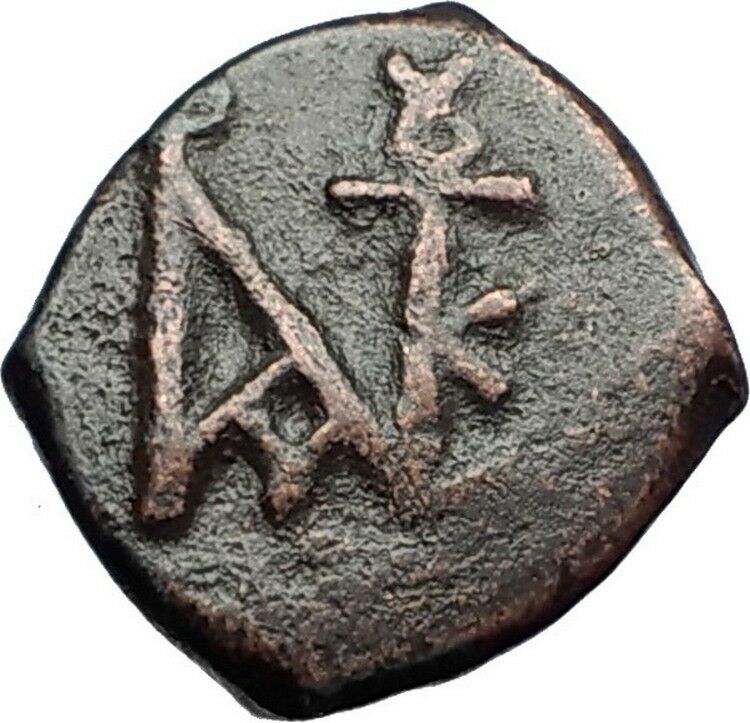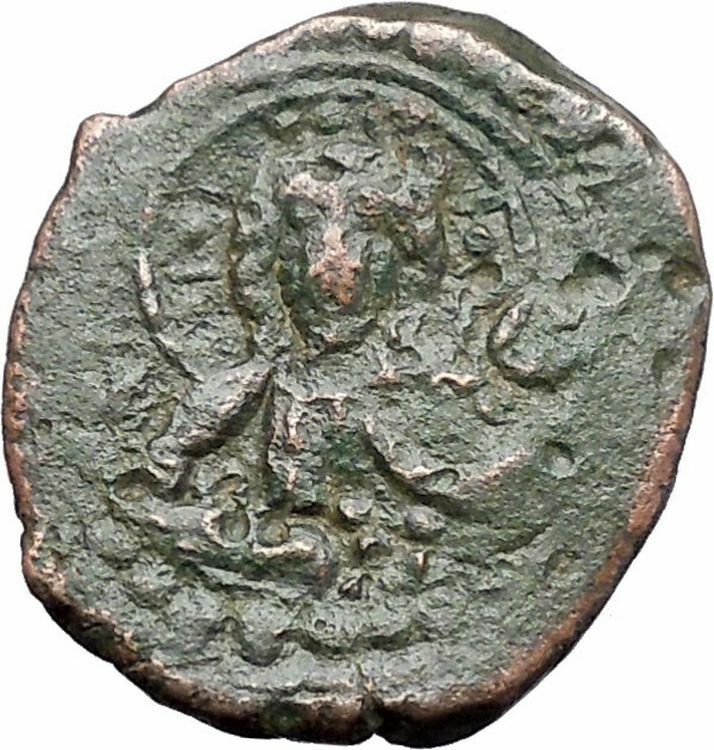|
Byzantine – Latin Rulers of Constantinople 1204-1261 A.D. –
Billon Aspron Trachy 26mm (2.17 grams) Constantinople mint: 1204-1261 A.D.
Reference: Sear 2046, H.,pl.29, 7-9 (C0. DO IV. pl.LII.32
The Virgin enthroned.
Emperor enthroned.
You are bidding on the exact item pictured,
provided with a Certificate of Authenticity and Lifetime Guarantee of
Authenticity.
The Latin Empire or Latin Empire of Constantinople (original
Latin
name: Imperium Romaniae, “Empire of
Romania
“)
is the name given by historians to the
feudal
Crusader state
founded by the leaders of the
Fourth Crusade
on lands captured from the
Byzantine Empire
.
It was established after the capture of
Constantinople
in 1204 and lasted until 1261. The Latin Empire was intended
to supplant the Byzantine Empire as titular successor to the
Roman
Empire
in the east, with a Western
Catholic
emperor enthroned in place of the
Orthodox
Byzantine emperors
.
Baldwin IX
,
Count of
Flanders
, was crowned the first Latin emperor as Baldwin I on 16 May 1204.
The Latin Empire failed to attain political or economic dominance over the other
Latin powers that had been established in former Byzantine territories in the
wake of the Fourth Crusade, especially
Venice
, and
after a short initial period of military successes it went into a steady
decline. Weakened by constant warfare with the Bulgarians and the Greek
successor states, it eventually fell to the
Empire of Nicaea
under Emperor
Michael VIII Palaiologos
in 1261. The last Latin emperor,
Baldwin II
, went into exile, but the imperial title survived, with several
claimants to it, until the 14th century.
//
History
Creation
of the Latin Empire
By arrangement among the crusaders, Byzantine territory was divided: in the
Partitio terrarum imperii Romanie, signed on 1 October 1204, three
eighths – including Crete
and other islands – went to the
Republic of
Venice
. The Latin Empire claimed the remainder, and did exert control over
areas of Greece
,
divided into
vassal
fiefs
:
the
Kingdom of Thessalonica
, the
Principality of Achaea
, the
Duchy of Athens
,
the
Duchy of the Archipelago
and the short-lived
duchies of Nicaea
,
Philippopolis, and
Philadelphia
.
The
Doge of Venice
did not rank as a vassal to the Empire, but his position in control of 3/8 of
its territory and of parts of Constantinople itself, ensured Venice’s influence
in the Empire’s affairs. However, much of the former Byzantine territory
remained in the hands of rival
successor states
led by Byzantine Greek aristocrats, such as the
Despotate of
Epirus
, the
Empire of Nicaea
,
and the
Empire of
Trebizond
, which were bent on reconquest from the Latins.
The crowning of Baldwin and the creation of the Latin Empire had the curious
effect of creating three so-called Roman Empires in Europe at the same time, the
others being the
Holy Roman Empire
and the remnants of the
Byzantine Empire
(the direct successor of the ancient Roman Empire), none of which actually
controlled the city of
Rome
, which was under the
temporal authority
of the
Pope.
The
Empire in Asia Minor

Capture of Constantinople during the
Fourth Crusade
in 1204.
The initial campaigns of the crusaders in Asia Minor resulted in the capture
of most of Bithynia
by 1205, with the defeat of the forces of
Theodore I Lascaris
at Poemanenum and Prusa. Latin successes continued, and
in 1207 a truce was signed with Theodore, newly proclaimed Emperor of Nicaea.
The Latins inflicted a further defeat on Nicaean forces at the Ryndakos river in
October 1211, and three years later the
Treaty of Nymphaeum (1214)
recognized their control of most of Bithynia and
Mysia
.
The peace was maintained until 1222, at which point the resurgent power of
Nicaea felt sufficiently strong enough to challenge the Latin Empire, by that
time weakened by constant warfare in its European provinces. At the
battle of Poemanenum
in 1224, the Latin army was defeated, and by the next
year Emperor
Robert of Courtenay
was forced to cede all his Asian possessions to Nicaea,
save Nicomedia
and the territories directly across Constantinople. Nicaea turned
also to the
Aegean, capturing the
islands awarded to the Empire. In 1235, finally, the last Latin possessions fell
to Nicaea.
The
Empire in Europe
Unlike in Asia, where the Latin Empire faced only an initially weak Nicaea,
in Europe it was immediately confronted with a powerful enemy: the
Bulgarian
tsar
Kaloyan
. When Baldwin campaigned against the Byzantine lords of
Thrace
, they
called upon Kaloyan for help. At the
Battle of Adrianople
on 14 April 1205, the Latin heavy cavalry was lured
into an ambush by Kaloyan’s troops, and Emperor Baldwin was captured. He was
imprisoned in the Bulgarian capital
Tarnovo
until his death later in 1205. Luckily for the new Latin Emperor,
Henry of
Flanders
, Kaloyan was murdered a couple of years later (1207) during a siege
of
Thessalonica
, and the Bulgarian threat conclusively defeated with a victory
the following year, which allowed Henry to reclaim most of the lost territories
in Thrace until 1210, when peace was concluded with the marriage of Henry to
Maria of Bulgaria
, tsar
Kaloyan
‘s daughter.
At the same time, another Greek successor state, the
Despotate of
Epirus
, under
Michael I Komnenos Doukas
, posed a threat to the Empire’s vassals in
Thessalonica and Athens. Henry demanded his submission, which Michael provided,
giving off his daughter to Henry’s brother Eustace in the summer of 1209. This
alliance allowed Henry to launch a campaign in
Macedonia
, Thessaly
and
Central Greece
against the rebellious
Lombard
lords of Thessalonica. However, Michael’s attack on the Kingdom of Thessalonica
in 1210 forced him to return north to relieve the city and to force Michael back
into submission.
In 1214 however, Michael died, and was succeeded by
Theodore Komnenos Doukas
, who was determined to capture Thessalonica. On 11
June 1216, while supervising repairs to the walls of Thessalonica, Henry died,
and was succeeded by
Peter
of Courtenay
, who himself was captured and executed by Theodore the
following year. A regency was set up in Constantinople, headed by Peter’s widow,
Yolanda of
Flanders
until 1221, when her son
Robert of
Courtenay
was crowned Emperor. Distracted by the renewed war with Nicaea,
and waiting in vain for assistance from Pope
Honorius III
and the King of France
Philip II
,
the Latin Empire was unable to prevent the final fall of Thessalonica to Epirus
in 1224. Epirote armies then conquered Thrace in 1225-26, appearing before
Constantinople itself. The Latin Empire was saved for the time by the threat
posed to Theodore by the Bulgarian tsar
Ivan II Asen
, and a truce was concluded in 1228.
Decline
and Fall
After Robert of Courtenay died in 1228, a new regency under
John of Brienne
was set up. After the disastrous Epirote defeat by the Bulgarians at the
Battle
of Klokotnitsa
, the Epirote threat to the Latin Empire was removed, only to
be replaced by Nicaea, which started acquiring territories in Greece. Emperor
John III Doukas Vatatzes
of Nicaea concluded an alliance with Bulgaria,
which in 1235 resulted in joint campaign against the Latin Empire, and an
unsuccessful
siege of Constantinople
the same year. In 1237,
Baldwin II
attained majority and took over the reins of a much-diminished
state. The Empire’s precarious situation forced him to travel often to Western
Europe seeking aid, but largely without success. In order to gain money, he was
forced to resort to desperate means, from removing the lead roofs of the
Great Palace
and selling them, to handing over his only son, Philip, to
Venetian merchants as a guarantee for a loan.
By 1247, the Nicaeans had effectively surrounded Constantinople, with only
the city’s strong
walls
holding them at bay, and the
Battle of
Pelagonia
in 1258 signaled the beginning of the end of Latin predominance in
Greece. Thus, on July 25, 1261, with most of the Latin troops away on campaign,
the Nicaean general
Alexios Strategopoulos
found an unguarded entrance to the city, and entered
it with his troops, restoring the Byzantine Empire for his master,
Michael VIII Palaiologos
.
Titular
claimants
For about a century thereafter, the heirs of Baldwin II continued to use the
title of Emperor of Constantinople, and were seen as the overlords of the
various remaining Latin states in the
Aegean
.
They exercised effective authority in Greece only when actually ruling as
princes of Achaea
, as in 1333–1383. Although they are generally regarded as
titular emperors, the continued existence of Latin states in the Aegean that
recognized them as their suzerains makes the term a misnomer; a more accurate
description would be emperors-in-exile.
Organization
and Society
Administration
The empire was formed and administrated on Western European feudal
principles, incorporating some elements of the Byzantine bureaucracy. The
Emperor was assisted by a council, composed of the various barons, the Venetian
podestà
and
his six-member council. This council had a major voice in the governance of the
realm, especially in the periods of regency, where the Regent (moderator
imperii) was dependent on their consent to rule. The podesta, likewise, was
an extremely influential member, being practically independent of the Emperor.
He exercised authority over the Venetian quarters of Constantinople and
Pera
and the
Venetian dominions within the Empire, assisted by a separate set of officials.
His role was more that of an ambassador and
vicegerent
of Venice than a vassal to the Empire.
Society
The elite of the empire were the Frankish and Venetian lords, headed by the
Emperor, the barons and the lower-ranking vassals and liege lords, including
many former Byzantine aristocrats. The bulk of the people were
Orthodox
Greeks
, still divided according to the Byzantine system in income classes
based on land ownership.
Church
As with all Latin states, the Orthodox hierarchy was replaced by
Catholic
prelates
, but not suppressed. An expansive Catholic hierarchy was
established, under the dual supervision of the Latin
archbishop
of Constantinople and the
Papal
legate
, until the two offices were merged in 1231. Catholic monastic orders,
such as the
Cistercians
, the
Dominicans
and the
Franciscans
were established in the Empire. The Orthodox clergy retained its
rites and customs, including its right to marriage, but was demoted to a
subordinate position, subject to the local Latin bishops.
|









